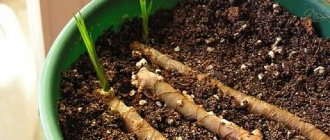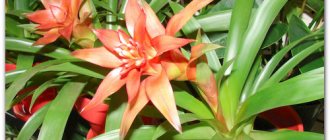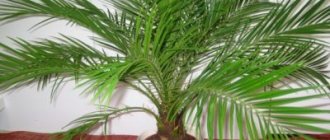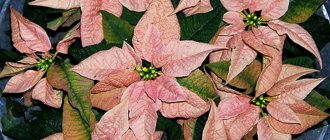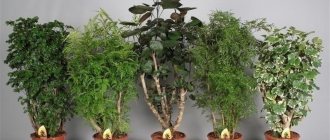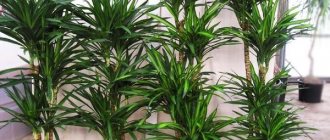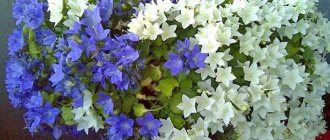The craving for everything exotic has not subsided for many decades. Cultivated outdoor trees are increasingly in demand among indoor plant lovers. At home and in offices there are mini-palm trees, cypress, ornamental spruce, lemon, pomegranate, pineapple, orange and other “smaller versions” of trees.
Marina Ivanova
He is an expert in his field and an experienced flower growing practitioner.
Ask a Question
One of the popular species among aesthetes and flower growers, which we will get to know today, is the “Dracaena”, better known as Dracaena. Let's get acquainted with its common species among gardeners and learn how to properly care for Dracaena.
Dracaena at home
Dracaena is suitable for growing in greenhouses, winter gardens, insulated loggias and balconies, in the halls of restaurants, hotels, it will decorate any music room of a kindergarten or school, it is an excellent plant for the office.
Any type of dracaena is well suited for growing at home, for the reason that they do not need cold wintering, such as many cacti, cycas or conifers. Artificial trees also require no maintenance.
When choosing a dracaena for your home, you need to consider how much space it will be given, because... Among the various types of dracaenas there are giant, dwarf, and quite compact forms of the plant. Young plants take up little space, but over time they grow and are not removed from the windowsill. You have to plant them in large pots and place them in the room. At the same time, variegated varieties require mandatory additional lighting. Use fluorescent lamps or LED lamps; for one large plant, 1.5 m high, you need approximately 2-3 lamps with a power of 20 W, and they should be placed no further than 20 cm from the crown, so that all parts of the plant are illuminated as evenly as possible .
The second feature of growing dracaena at home concerns large tub plants, for example, fragrant dracaena can grow to the ceiling and the span of its leaves is about 1-1.2 m. Such a specimen can only grow in a tub or a very large flowerpot, about 40-50 l. Naturally, this creates difficulties during replanting; such plants are replanted rarely, once every few years, but the top layer of soil is changed annually, especially if a coating of salts has been deposited on it. The soil must first be loosened, then removed with a scoop and topped with fresh soil or well-rotted compost.
The most unpretentious species: Dracaena marginalata, Dracaena fragrant, Dracaena derema - larger, Dracaena Godsefa, Dracaena reflexum - more compact. By the way, out of all the variety of more than a hundred species of dracaenas, about 15 species are grown as indoor plants.
Brief description and varieties of “Dragon Tree”
A variety of succulent shrubs, originally from the hot countries of Africa and part of the countries of Eurasia, was initially loved by people for their beneficial properties. Residents of India and China actively used the juice of the “progenitors” of Dracaena as a dye and valued it for its medicinal properties.
To us, European residents, Dracaena is known as a decorative deciduous tree that looks like a palm tree.
This is interesting! It is worth noting that the plant has nothing to do with the palm genus. Since the 19th century biologists have identified cultivated varieties into an independent family - Dracaenaceae.
Kinds
The following varieties are found in flower shops and greenhouses:
- Dracaena marginata or Marginata. The leaves are arrow-shaped, elongated, smooth. Its peculiarity is that as the tree grows, a crown is formed, the lower leaves fall off and thereby form a trunk with scales, making the plant look like a palm tree. The maximum known height of such a tree in closed ground is about 3 m. There are 3 varieties in accordance with the color of the edging of the foliage - Magenta, Bicolor and Tricolor. The most capricious to care for for beginners is Tricolor. The most unpretentious is Magenta;
Dracaena Bicolor
- Dracaena reflexa or Reflexed. The peculiarity is the weakly expressed ornate trunk. It looks like the foliage is growing downwards. Oblong oval leaves with yellow longitudinal stripes. This species does not usually grow to gigantic sizes;
- Dracaena Godsefa (Surculosa), Golden. Outwardly it looks more like a bush. Oval green leaves with beige speckles. Grows to medium size - 40-50 cm;
- Dracaena Fragrance or Fragrant. One of the few varieties that blooms at home with white or yellowish flowers. But more often, this happens with plants in botanical gardens or garden plots. In open ground, where the height reaches 4-5 m. The foliage is colored with light or dark green longitudinal veins and vaguely resembles bamboo - in color, shape and method of attachment to the trunk;
- Dracaena Derema. Outwardly it looks like a cross between two varieties of Dracaena - foliage like the Fragrant one and a trunk like the Marginata variety. It is difficult to achieve flowering at home, but in open soil, freshly blossomed red flowers emit an extremely unpleasant odor. So, in this case, not flowering the plant at home is rather an advantage.
Marina Ivanova
He is an expert in his field and an experienced flower growing practitioner.
Ask a Question
Keep in mind! All Dracaenas have a fairly powerful root system. If the tree is young, healthy, and growing, it can pierce a plastic pot with its roots. Therefore, we recommend planting young animals in ceramic flowerpots.
When the period of intensive growth is over, promptly transplant the tree into large-volume plastic or ceramics, such as a “tub”. It is better to place it on the floor or on a stand.
Would you like a dracaena for yourself?
Of course! I don't know
Types of dracaenas
Temperature
Dracaena prefers moderate temperatures; in summer it can suffer from extreme heat when the temperature is above 32°C. To alleviate its condition, temporarily move the pot to a cooler place, ventilate the house more often and spray the leaves. Monitor watering carefully and do not allow it to dry out. Since October, the illumination drops sharply, at home it can be very dark even on the windowsill, and if the plant is standing near a window or slightly away, high temperatures are harmful to the plant - moderate temperatures within 15-18 ° C are desirable, it can be kept on an insulated balcony up to 10 - 12°C with limited watering. If it is not possible to provide coolness, protect the plants from central heating radiators (with a screen, wet sheets on the radiator). In a warm room with a lack of light, dracaenas very quickly lose their lower leaves and decorative appearance. Therefore, the only way to preserve the plant’s health and beauty is additional lighting.
Lighting
You need a bright place, partial shade, dracaena does not tolerate direct sunlight only from 11 a.m. to 4 p.m. Many people consider dracaena to be a shade-loving plant, but in fact, it will wither in a dark place. Intense light is needed for good growth and development. Variegated forms require more lighting than forms with green leaves. The issue of lighting large plants in winter is especially acute. Such large dracaenas are bought or given as a gift to decorate rooms, but they rarely think that they need light.
Dracaena also grows well in artificial light, so arrange illumination with fluorescent lamps (for a plant about 1.5 m tall you need 2-3 lamps with a power of 15-18 W) or LED. The lamps should be placed so that the crown is illuminated most evenly. By the way, the most shade-tolerant species is Dracaena fragrant (not the variegated version). If you live in central Russia, then keep in mind that from mid-September to January, dracaena is not afraid of even the midday sun from a southern window (the sun is low and rare to cause burns).
How to properly care for Dracaena
By adhering to a number of simple rules, your tree will thrive in health:
- Don't fill it up. For beginners, we recommend the “smart pots” system with an indicator float. Excellent for an adult plant. It looks like a tub with an internal tray into which a “float” is mounted. During the care process, watering is carried out into the float funnel, water enters the pan and moistens the root. For experienced gardeners - any flowerpot, always with a perforated bottom;
- Keep an eye on the soil level. Dracaena does not like “bare roots”. Add soil regularly as the soil in the pot shrinks;
- The tree breathes leaves and roots. When planting, be sure to use expanded clay drainage. You can lay it in 1 or 2 layers - under the root and closer to the surface. This will retain moisture longer if you live in an area of high temperatures;
- Feed once every 3 months. and transship once a year;
- Bathe once a week and spray daily during the hot season. Wipe off dust from foliage;
- Place the tree on the loggia in the summer. On a closed balcony it is permissible to “stay until the cold weather”, on an open one - always bring it into the house at night;
- Protect from direct sunlight - they are destructive to foliage;
- For irrigation, use exclusively settled water.
Marina Ivanova
He is an expert in his field and an experienced flower growing practitioner.
Ask a Question
Advice! It is possible to achieve softening of water by freezing it in the freezer. Place any water in the freezer for a day, defrost, let it warm up to room temperature and can be used for irrigation. Drain off the sediment.
The best gift is a living plant
Don't be afraid to take "sick" plants. If you take one risk, you doom yourself to happiness. The most unassuming flowers need your care and attention. They thank their owners for their rare colors, lush foliage and flowering for many years. When you give your love to a houseplant, you will be surprised at how grateful they will be.
Evolution of Dracaena Tricolor in a year and a half
Before, a diseased plant was purchased
sick dracaena
After, 1.5 years later
healthy plant
Period of active growth of dracaena
A period of strong growth has been mentioned many times. Typically, this time falls in the spring months of March-April and the autumn months of September-October. You will notice these stages yourself in your plant. Because your “favorite” will significantly increase in size almost before your eyes, relative to other periods.
What types of dracaena are there?
There are 3 varieties according to the color of the edging of the foliage - Magenta, Bicolor and Tricolor. The most capricious to care for for beginners is Tricolor. The most unpretentious - Magenta
What kind of lighting should there be?
Like most plants, the tree loves diffused sunny color. In spring and summer, starting from t +7 C, the plant feels great on a glassed-in loggia, where it lives safely until the first frost. Protect the crown from direct sunlight, the plant can get burned.
Watering
In summer or winter, with good lighting in a warm room (above 24°C), water abundantly after the top layer of soil has dried (about half the height of the pot). In winter, under cool conditions, especially with poor lighting, dracaenas are watered moderately or limitedly, taking into account the temperature in the room (for example, when kept at a temperature of about +8 ° C, the soil in the pot should always be almost completely dry, watering is scanty, about once every 1 ,5 months). Do not overdo it with watering - all dracaenas do not tolerate stagnation of water in the pot, as well as prolonged drying of the earthen clod. If you are in doubt about watering or it’s too early, wait. To avoid waterlogging, check whether the drainage holes are clogged with expanded clay or soil, and be sure to add drainage to the bottom of the pot when replanting. Small dracaenas are suitable for growing hydroponically.
Fertilizer
During the growth period from April to August, dracaenas are fed every two weeks with complex fertilizers for indoor plants. The ideal ratio of the main macroelements in NPK fertilizer is 3:1:3, somewhat worse than 3:1:2. It is quite difficult to select fertilizers, but you can, for example, “Stimulus for decorative deciduous organomineral fertilizer” - NPK 3: 1.5: 2 and microelements S, Mg, Fe, Mn, Cu, Zn, B, Mo. Not everyone from the Agricola line is suitable, perhaps only Agricola for ficuses, it has an NPK of 24:11:18, an additional 0.5% MgO and trace elements, if you recalculate the NPK ratio, it is approximately 3:1.38:2, 25 - will completely satisfy the needs of dracaena. Other fertilizers for deciduous trees have too high a dose of phosphorus; fertilizing with such fertilizers will lead to the formation of necrotic (dark brown) spots along the edges of the leaves.
Don’t look for special fertilizers for dracaenas, look for a suitable NPK ratio, for example, Bona Forte also has fertilizer for ficuses or for decorative deciduous trees - but they also contain too high a dose of phosphorus. But Bon Forte has a liquid Lawn Fertilizer - this is a complex mineral fertilizer, with NPK 7: 3.5: 7 - practically what we need + 7 microelements: Boron, iron, manganese, zinc, copper, molybdenum, cobalt.
All you need to do is find a fertilizer with the correct NPK ratio and convert it to the required amount of water. For example, fertilizer “for lawns” from Bon Forte will need to be diluted twice as much as the dosage recommended on the package, and fertilizer “Stimul” must be diluted according to the instructions.
How to replant dracaena
Dracaena should be replanted at the beginning of a new growth cycle - in spring, early summer. Young plants need to be replanted annually, as plants grow vigorously, quickly using up nutrients. Old dracaenas (over 6-7 years old) can be replanted every two to three years.
It is better to compose the soil for dracaena yourself from various components: 1 part turf soil, 1 part leaf soil, 1 part rotted manure (compost) and 1 part coarse sand (more precisely, fine gravel 3-4 mm in size).
If you use soil for dracaenas from a store, choose trusted manufacturers (for example, Terra Vita Living Earth). But to such soil it is advisable to add 1/5 of the volume of fine gravel or coconut shavings (chips) and the same amount of compost (humus). But in any case, the soil must be sterilized.
The root system of dracaenas is relatively small and rather superficial; it does not tolerate waterlogging, so the pot has high drainage. You can plant dracaenas in purchased soil for palm trees and other large plants, or in universal soil. However, it is a good idea to add loosening elements (fine gravel, coconut substrate) to such soil in an amount of 1/5 of the volume of the pot.
Special care requirements for dracaenas
Dracaenas are very sensitive not only to chlorine contained in tap water, but also to elements such as fluorine and boron.
To get rid of chlorine, just let the water sit for 24 hours. However, if there is an excess of fluoride in tap water in your area, settling will not help; filtering reduces its content to some extent, but only slightly. Only filters with reverse osmosis are better at purifying water from this chemical element. If you do not have such a filter, the best solution is to water your dracaenas with distilled water. In addition, it is important to avoid fertilizers and soils containing superphosphates - they have a high fluorine content. Perlite and vermiculite are also prohibited for dracaenas - they contain high levels of fluoride.
Acidity is also important, so that plants do not get fluoride poisoning, maintain the soil pH in the region of 6-6.5 units (the amount of fluoride bound by the soil increases as the pH decreases). When the acidity pH is below 6.0, dracaena may experience leaf spotting, necrosis of the tips and edges of leaves - a deficiency of Potassium, possibly simultaneously with the accumulation of fluoride. Sometimes these are single brown spots located closer to the edges. At a pH above 6.5, iron deficiency occurs and appears as chlorosis, primarily on young leaves.
Reproduction of Dracaena Fragrance
Possible reproduction options:
- Cuttings. The most common option. The shoots are cut from the top of the crown. In order for them to take root, a substrate is used. The container is covered with glass or film. The plant takes root after 1 month.
- Layerings. Layers are obtained by making a cut along the trunk to the middle. To prevent the edges of the crack from closing, you need to install a match in the cut. This area is insulated with moss and polyethylene.
- Stem segments. The stem is cut so that at least 2 buds remain in each section. The length of such cuttings can vary: from 5 to 15 cm. They must be rooted using light soil.
- Seeds. The plant reproduces infrequently using seeds, which is due to rare flowering in everyday life. In this case, it is necessary to artificially pollinate the flowers using a brush.
How to propagate dracaena
Dracaena - propagation Dracaena can be propagated by seeds and cuttings (pieces of stem). In any case, propagation is best carried out from the end of February to May, so that the seedlings or rooted cuttings have time to get stronger by winter.
Before planting, seeds should be soaked for a day in water at room temperature. It is possible, but not necessary, to add growth stimulants - epin or zircon - to the water. Plant the dracaena in a small pot (8-10 cm in diameter), to a depth of no more than 1 cm. You need to add expanded clay drainage to the bottom of the pot. The soil is a universal peat or soil for seedlings; you can add a tablespoon of coconut substrate (from briquettes) to it. Be sure to sterilize the soil! Plant the cutting and water the soil in the pot. Now you need to create increased humidity - place the pot in a transparent bag or cover it with a jar. Ventilate twice a day.
Germination takes on average 2 weeks, sometimes longer. But even if the seeds have not sprouted within a month, do not be discouraged, they can linger for up to three months. Caring for crops is like caring for any other flowers - it is important not to overwater them or overdry them. The soil should be constantly moderately moist. If they stretch noticeably, organize additional lighting.
Dracaena, which has become elongated and bald in the lower part of the trunk, is most often propagated by apical cuttings or pieces of a trunk at least 10 cm long. In spring, cuttings take root well in water (1 liter of boiled water, add 1 tablet of activated carbon). The roots appear within 1-3 months. When they grow to a length of 5 cm, you can plant the dracaena in a pot. Rooting dracaena in the ground using heteroauxin and heating the soil is also practiced, but only small cuttings. In this case, the soil must be sterilized, and the plant itself must be placed in a ventilated greenhouse. By the way, at the place where the cuttings are cut, new shoots from the lateral buds will appear on the mother plant.
How to prune a plant
Follow the following recommendations:
- To get a branched plant (with several trunks), the crown is cut below the level of the leaves by 15 cm.
- The cut areas are treated with activated carbon.
- After 1 month, new shoots appear on the trunk, from which a multi-stemmed shrub grows. Excess shoots (if there are more than 5 shoots) are removed.
The cut crown is placed in a pot, first without soil - to dry. Then a mixture of sand and peat is added and covered with film to create a greenhouse effect. The plant should be placed in a warm room, the covering should be removed daily for 30 minutes for ventilation.
Dracaena turns yellow
- Brown, dry tips or edges of leaves - if the leaves are elastic, the cause is too dry air or insufficient watering.
This dracaena has two problems: too much watering and too large a pot, in which the soil turns sour and the roots rot. - Limp, drooping leaves of dracaena can be a sign not only of a regular flood, but also of hypothermia, especially if the root system was damp (a cold night on the balcony, transportation from the store to home).
The main problem with this dracaena is the lack of light, so the lower part of the trunk becomes bald, and the crown reaches towards the light. - Yellowing of leaves - if the leaves are elastic and not flaccid, then the cause may be insufficient watering, lack of nutrition, if they have not been replanted for a long time. If the air is too dry, directed (from the battery), then in addition to yellowing, there may be dry round spots on the leaves, usually gray.
Dracaena fragrant is very shade-tolerant, and such yellowing of the leaves is evidence of a violation of watering (overdrying, overwatering, or, what happens more often, first severe drying out, and then excessive watering).This dracaena was frozen - the leaves turned black from contact with cold air during ventilation. Hypothermia is especially dangerous when the soil in the pot is damp.
This dracaena was watered very diligently - a sure sign of waterlogging and root rot is the death of the top; usually at this stage the plant cannot be saved.
- The lower leaves turn yellow and fall off - it is typical for dracaena to lose the lower leaves, while the upper part of the plant remains leafy. But it can be considered more or less normal for the trunk to be exposed 1/3 from the bottom. If a large part is exposed, then it is worth considering whether the plant has enough light.
- Light large dry spots on the leaves, then turn brown, with clear boundaries - too intense lighting and sunburn. Dracaena needs shade from direct sunlight during the hottest hours of the day.
How to save dracaena if it is sick. If there are signs of a lack of lighting, then move the plant to a brighter place or provide additional lighting with fluorescent lamps.
If the plant suffers from dry air, then, firstly, you can cover the radiators with a damp sheet. Secondly, place the pot with dracaena on a tray with wet pebbles or sphagnum moss. But this will not help a large plant; the only way out is a humidifier.
If the dracaena was flooded, then the degree of its survival depends on how badly the roots were damaged (rotted). In any case, you need to try to save the plant - remove it from the pot, shake off the damp clods of earth and dry the root ball with newspapers or toilet paper. Then plant in dry soil and do not water for about 2 days, then water carefully.
How to care for dracaena
One of the advantages of any type of Dracaena is their relative ease of care, which means that any novice gardener can certainly cope.
During a period of active growth
A period of strong growth has been mentioned many times. Typically, this time falls in the spring months of March-April and the autumn months of September-October. You will notice these stages yourself in your plant. Because your “favorite” will significantly increase in size almost before your eyes, relative to other periods.
We also have an interesting article about ficus trees, about growing which you can read in this article.
Lighting
Like most plants, the tree loves diffused sunny color. In spring and summer, starting from t +7 C, the plant feels great on a glassed-in loggia, where it lives safely until the first frost.
Protect the crown from direct sunlight, the plant can get burned.
Indoor care during the period of active growth involves additional recharge from a fluorescent lamp, which will saturate the flower at night.
Note! Many “domesticated” Dracaena species do not tolerate drafts, but at the same time they actively grow in the fresh air. The solution is simple: if you decide to move the tree to a glazed loggia, make sure that the plant is not under moving air currents. It is enough for him to open a window or window at a distance for the flow of oxygen.
Tricolor on a glazed loggia in summer
Watering
Dracaena is a moisture-loving plant that “breathes” its leaves. She accepts watering in the ground, in a tray, and loves spraying. Its “element” is the hot and humid climatic conditions of the tropics.
The plant is quite “intelligent” and conducts a dialogue with its owner. For example, Bordered, signals to its “owner” about an insufficient amount of moisture in the form of drying out the tips of the foliage.
Drying Bicolor
As soon as you see an SOS signal from your pet, check the soil moisture level. If the soil is moist to a depth of half a finger, this is enough. This means that the problem is dry air and the plant needs spraying. As soon as the moisture deficit is eliminated, Dracaena will thank you with a freshly released bunch that forms a green crown, and the drying foliage will be shed over time to form the stem part.
Healthy Bicolor
Fertilizer
The fertilizer market offers a wide range of fertilizers. However, if you have other types of plants in your home, we do not recommend spending money on a “personal treat” for Dracaena. She takes supplements well in the form of All Purpose Fertilizer for Foliage Plants.
Fertilizer sticks
Marina Ivanova
He is an expert in his field and an experienced flower growing practitioner.
Ask a Question
Advice! How to avoid oversaturation with liquid fertilizer. Use All-Purpose Fertilizer in stick form. It is very convenient and economical. The packaging is designed for several pots, into which sticks are stuck in an amount that is a multiple of the volume of the pot. Each package contains detailed instructions for use. The sticks are completely degradable and despite the stated 1-2 months. saturation of the soil with nutrients, in fact they are enough for 3-4 months.
Fertilizer "sticks" in the ground
Transfer
Transshipment of Dracaena is carried out as it grows out of the pot. When the root system reaches the bottom of the container in which the tree is planted, it begins to twist into a spiral. Despite the strong opinion of professional flower growers that the smaller the flowerpot, the larger the plant goes into the crown, and that Dracaenas grow slowly, it shows in practice that this is not always the case.
Advantages of transshipment every autumn:
- monitoring the condition of the root system;
- timely detection of possible root diseases and pests;
- By “planting” each time in fresh soil, you prevent depletion and alkalization of the soil.
Dracaena Bicolor, at home, increases proportionally both in depth and in height during periods of active growth. The need for transshipment with proper care arises every September. If it is necessary to correct the crown or for the purpose of propagation, this can be done every April.
Pests of dracaenas
Most often, dracaena is affected by scale insects, thrips and mites.
Scale insects look like brown plaques on the surface of leaves and stems and suck out cell sap. Leaves lose color, dry out, curl and fall off.
Thrips look like small black rods (about 1 mm long), but their excrement is more often noticeable - sticky black droplets. Light dots and streaks appear on the leaves, they quickly merge into large spots. As a result, the upper side of the leaf becomes grayish-brown, with a characteristic silvery sheen.
Control measures. Systemic insecticides help against thrips and scale insects (as well as whiteflies and aphids), especially if the plant is large and difficult to spray thoroughly. The drugs of choice are Aktara and Confidor. These drugs need to be watered on the ground, and they are the safest for humans. You can also spray with contact or enteric contact preparations (Fitoverm, Decis, Actellik, Inta-Vir).
Mites are difficult to detect on a plant until they have formed a huge colony. But if you look closely, on the underside of the leaf you can see a whitish husk, similar to dandruff - the skins of mites and larvae. The leaves of the dracaena become discolored, turn yellow and fall off, and when exposed to the light of the leaf, you can see pinpoint punctures, as if the leaf had been pricked with a needle.
Control measures. Only with the help of acaricide preparations, all of them are intended for spraying. Small dracaena bushes can be saved from ticks if you give them a hot shower: take the plants to the bathroom, lay them on their sides and water them with hot water from the shower for about 2-3 minutes. The water should be approximately 50-55 degrees. After 5-7 days, repeat the dousing from the shower.
You can’t take large plants into the bathroom; you have to use pesticides. But if you are afraid to use poisons (for example, you have children at home), you can try spraying dracaena leaves with a solution of green soap. The solution does not smell, but the effect is rather weak; there is no need to wash off the green soap, leave it until it dries.
Be sure to increase the humidity in the room; mites multiply intensively in dry air and high temperatures.
Read more about pests of indoor plants in the pests section.
Reproduction of dracaena Marginata, Bicolor, Tricolor. Trimming
Typically, pruning of Dracaena occurs for propagation. This plant multiplies by shoots in the varieties Surculoza, Fragrance, Bent, less often Marginata and Deremskaya. Or divided by cuttings.
Formed Marginata plants are divided in two ways:
- Cut the main part of the trunk in half;
- Divide into small pieces of 5-10 cm.
If the plant is “halved,” then the root part is left in the ground and cared for as usual for an adult plant.
Sprouted Bicolor root
After 3-4 weeks, the top of the cut will dry out, and buds will form below. Decide right away how many tops you need. While they are young, it is possible to cut off the excess ones and the tree will release a bud in another place or complete budding.
Sprouted tricolor crown
The area with the crown is placed in settled water until roots appear. After 2 weeks the first roots appear.
Penechek at Bicolor
Advice! Looking at the places where buds form, immediately form a crown. During this period, the further appearance of the tree becomes clear. If you do not want the plant to have 2-3 branches, to look more like a palm tree, then a sprouted crown is best suited for this purpose. Since there will already be a “stump” above the root system that will not be hidden by the foliage.
Root of the top of the Tricolor If the trunk was cut into 5-10cm pieces , be sure to immediately lay them in a row so as not to confuse the top and bottom! There are 2 ways to germinate them - horizontal and vertical.
Vertical - by analogy with “halving”, but for horizontal, make sure that the “stump” does not completely sink into the water, but seems to float in it to the middle of the thickness of the trunk. Then the roots will sprout from below, and the crown will bud upward.
Spathiphyllum and anthurium are also propagated by cuttings.
Pest Control
Flower counters have a wide variety of modern pesticides in their arsenal that can combat any pest without damaging the plant. But more often you have “first aid” products at hand at home, for example, laundry soap or potassium permanganate.
You need to know the enemy by sight
- Scale insect and false scale insect. If on your Dracaena, strange dense brown or yellow plaques appear on the leaf veins on the inside or outside, it’s time to sound the alarm;
- If the Dracaena leaf has shrunk, changed color to silver, and small insects are observed, then it is not always aphids. This is how thrips behave. Dangerous insect pests that can infect almost any indoor plant;
- Thin cobwebs, beige and pale yellow blotches on the foliage are a signal of the appearance of a spider mite.
These are the most common pests. But for 15 years of keeping Dracaena bicolor, I was lucky enough to avoid any pests. However, forewarned is forearmed!
The method of controlling these pests is identical:
- Clean the contaminated surface with a cloth, napkin, or brush. Using a weak solution of laundry soap. Or treat with a weakly acidic solution of potassium permanganate;
- If possible, completely remove damaged foliage by pruning or tearing off;
- After “cleaning,” isolate the plant from others and treat it with an insecticide.
Do not forget to carry out preventive measures for neighboring indoor flowers that may have become infected. Isolate Dracaena from other plants for a 14-day “quarantine” period.
By the way
In the summer, it is better to place the dracaena in the garden or on the balcony, providing it with shelter from the wind and bright sun. Uniform lighting from all sides in the open air promotes better foliage of the plant.
But before you bring the plants back into your apartment, make sure it is free of pests.
In appearance, Dracaenas are often confused with Cordylines. To distinguish them you will have to remove the plant from the pot. In dracaenas, the roots are even and smooth in color from orange and yellow to light brown, while in cordilina they are white.
In addition, cordylines never form root suckers.
Dracaenas with wide leaves require more abundant watering during the growth period than dracaenas with narrow leaves, since their leaves evaporate more moisture.
It should also be noted that fragrant dracaena, the most broad-leaved of all species, often suffers from mechanical damage. Its leaves are easily bent and cracks and scars form on them.
And dracaenas with narrow leaves (for example, Dracaena marginata) are loved by cats and cats.
Therefore, do not place large plants somewhere in the passage, next to the door. And grow special grass for the cat.
Dracaenas respond very well to periodic loosening of the top layer of soil in pots in spring and summer. This improves soil aeration. If the top layer of soil in a pot with dracaena is covered with a white crust - these are deposits of salts from water and soil, you need to remove the top layer of soil and add fresh soil. And for irrigation use boiled water.
When transplanting dracaenas, add pieces of charcoal (birch) coal and expanded clay (fraction 3-5 mm) to the fresh soil mixture in addition to sand. For a bucket of earth, three handfuls of coals and 0.5 liters of expanded clay. Pieces of coal prevent the development of rotting processes, and brick chips increase the looseness of the soil.
